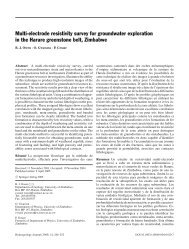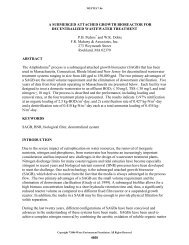Species diversity in the Florida Everglades, USA - Environmental ...
Species diversity in the Florida Everglades, USA - Environmental ...
Species diversity in the Florida Everglades, USA - Environmental ...
Create successful ePaper yourself
Turn your PDF publications into a flip-book with our unique Google optimized e-Paper software.
268 M. T. Brown et al. Ecosystem bio<strong>diversity</strong> <strong>in</strong> <strong>the</strong> <strong>Florida</strong> <strong>Everglades</strong><br />
example, <strong>in</strong>solation and carnivore metabolism may be<br />
reported <strong>in</strong> similar units (Joules per time), but have dramatically<br />
different properties and potentials with<strong>in</strong> an<br />
ecosystem. Odum (1996) concludes that energy alone is<br />
an <strong>in</strong>suffi cient numeraire for describ<strong>in</strong>g <strong>the</strong> fl ows <strong>in</strong> selforganiz<strong>in</strong>g<br />
complex systems.<br />
Emergy, formally defi ned as <strong>the</strong> energy of one form<br />
(usually solar energy) required through all processes and<br />
transformations to make a product or fl ow, provides a<br />
numeric framework for comparison of species contributions<br />
to ecosystem organization <strong>in</strong> directly comparable<br />
units (solar emjoules, or sej). Emergy is often referred to<br />
as energy memory, refl ect<strong>in</strong>g that this system syn<strong>the</strong>sis<br />
approach is effectively a form of account<strong>in</strong>g that traces<br />
energy fl ow and dissipation back through all necessary<br />
transformations to scale all fl ows relative to a common<br />
energy benchmark (solar equivalent energy). Emergy<br />
syn<strong>the</strong>sis allows comparison of energy fl ows of different<br />
form; Odum (1996) argues that different forms of energy<br />
have different qualities that arise from <strong>the</strong> energy required<br />
to make <strong>the</strong>m. In a self-organiz<strong>in</strong>g adaptive system,<br />
he argues, forms of energy that require larger <strong>in</strong>vestment<br />
per unit available energy (i.e., exergy) must provide<br />
commensurate higher quality cybernetic work <strong>in</strong> <strong>the</strong><br />
form of feedback control. Transformity is an <strong>in</strong>dex of<br />
quality and quantifi es <strong>the</strong> emergy <strong>in</strong>vested per unit available<br />
energy produced (i.e., emergy per exergy, sej/J) for<br />
each fl ow <strong>in</strong> a system of <strong>in</strong>terest. Direct comparison of<br />
energy fl ows, both with<strong>in</strong> and across <strong>the</strong> system boundary,<br />
is mislead<strong>in</strong>g until physical fl ows have been adjusted<br />
by <strong>the</strong>ir transformity values that refl ect <strong>the</strong> work necessary<br />
for <strong>the</strong>ir production.<br />
In <strong>the</strong> context of evaluat<strong>in</strong>g ecosystem bio<strong>diversity</strong>,<br />
<strong>the</strong> emergy framework suggests that evaluat<strong>in</strong>g species<br />
importance based on biomass or available energy<br />
throughput alone, without adjust<strong>in</strong>g for transformity, will<br />
tend to dramatically underestimate <strong>the</strong> system-scale control<br />
potential of energy fl ows <strong>in</strong> upper trophic levels,<br />
where only a small fraction of total system physical<br />
throughput is <strong>in</strong>corporated. That is, <strong>the</strong> importance of upper<br />
trophic levels with respect to carbon or energy<br />
throughput is small compared with <strong>the</strong>ir actual role <strong>in</strong><br />
ecosystem function, which <strong>in</strong>cludes cybernetic control<br />
(e.g., control of population at lower trophic levels, seed<br />
dispersal, commensal relationships, ecosystem structural<br />
attributes). For example, Terborgh et al. (2001) show<br />
dramatic changes <strong>in</strong> vegetative community composition<br />
<strong>in</strong> <strong>the</strong> absence of predators, suggest<strong>in</strong>g top-down ecosystem<br />
control. Pandolfi et al. (2003) similarly illustrate <strong>the</strong><br />
<strong>in</strong>fl uence of remov<strong>in</strong>g upper trophic level consumers <strong>in</strong><br />
coral reef degradation. Odum (1996) argues that methods<br />
for energy fl ow analysis should <strong>in</strong>corporate <strong>the</strong> relative<br />
energetic contributions (i.e., importance value) of each<br />
component by adjust<strong>in</strong>g for transformity (quality) to<br />
avoid misrepresent<strong>in</strong>g <strong>the</strong>ir <strong>in</strong>fl uence.<br />
Bio<strong>diversity</strong> <strong>in</strong>dex at <strong>the</strong> ecosystem scale. The Shannon<br />
<strong>diversity</strong> <strong>in</strong>dex (Eq. 1) disaggregates <strong>diversity</strong> <strong>in</strong>to two<br />
components: 1) richness or variety and 2) evenness or<br />
dom<strong>in</strong>ance. That is, more taxa variety or more evenness<br />
among <strong>the</strong> taxa present will <strong>in</strong>crease H (<strong>the</strong> <strong>in</strong>dex quantity);<br />
<strong>the</strong> maximum value of H (H max) is observed when<br />
observation probabilities (p i) are equal across all taxa.<br />
When p i are defi ned based on physical stocks, <strong>the</strong> implicit<br />
assumption is that a basis for ecosystem condition<br />
can be <strong>in</strong>ferred from <strong>the</strong> deviation a system displays from<br />
maximum evenness of all compartments. S<strong>in</strong>ce <strong>the</strong> <strong>in</strong>tent<br />
of p i for ecosystem evaluation is to capture <strong>the</strong> importance<br />
of each component with<strong>in</strong> <strong>the</strong> ecosystem (not<br />
with<strong>in</strong> a s<strong>in</strong>gle trophic level), physical stocks are a poor<br />
surrogate for <strong>the</strong> functional role any actor plays. In particular,<br />
<strong>the</strong> expectation of evenness <strong>in</strong> physical stocks or<br />
fl ows is <strong>in</strong>appropriate when compar<strong>in</strong>g across trophic<br />
levels; <strong>the</strong> sequential reduction <strong>in</strong> energy (or biomass,<br />
cover, abundance) through repeated transformations<br />
(Fig. 4) serve to make higher trophic level importance<br />
values <strong>in</strong>creas<strong>in</strong>gly small relative to lower trophic levels.<br />
The association between richness (component 1) and<br />
trophic level is complex (e.g., typically, richness of <strong>in</strong>sects<br />
> plants > mammals; this does not hold for <strong>the</strong> <strong>Everglades</strong><br />
gram<strong>in</strong>oid marshes that are strongly monotypic<br />
<strong>in</strong> <strong>the</strong>ir plant community), but <strong>the</strong> effect of trophic dynamics<br />
on dom<strong>in</strong>ance (component 2), when measured<br />
us<strong>in</strong>g ei<strong>the</strong>r physical stocks or fl ows, is dramatic.<br />
To compensate for this problem, we depart from <strong>the</strong><br />
standard Shannon <strong>diversity</strong> implementation <strong>in</strong> two ways.<br />
First, by apply<strong>in</strong>g <strong>the</strong> <strong>in</strong>dex to network fl ows ra<strong>the</strong>r than<br />
stand<strong>in</strong>g stocks, we follow <strong>the</strong> orig<strong>in</strong>al <strong>in</strong>tent of <strong>the</strong> <strong>in</strong>formation<br />
<strong>the</strong>oretic approach <strong>in</strong> ecology (MacArthur, 1955).<br />
S<strong>in</strong>ce only fl ows can actually transmit <strong>in</strong>formation with<strong>in</strong><br />
an ecosystem sett<strong>in</strong>g, <strong>the</strong>ir determ<strong>in</strong>acy is of considerably<br />
more ecological <strong>in</strong>terest than <strong>the</strong> distributions of biomass<br />
compartments (Ulanowicz, 2001). A second departure,<br />
follow<strong>in</strong>g Odum (1996), is that <strong>the</strong> Shannon <strong>diversity</strong><br />
should be computed based on fl ows that have been scaled<br />
by appropriate scal<strong>in</strong>g values (transformities) to adjust for<br />
<strong>the</strong> expected decl<strong>in</strong>e <strong>in</strong> physical stock dom<strong>in</strong>ance with<br />
sequential energy transformation (Fig. 4).<br />
A transformity-adjusted <strong>in</strong>dex of compartment importance<br />
offers <strong>in</strong>formative characteristics with respect<br />
to <strong>the</strong> balance of emergy fl ows throughout a system only<br />
when provided <strong>in</strong> contrast to some <strong>the</strong>oretical benchmark.<br />
The Shannon <strong>diversity</strong> computation <strong>in</strong> ecology is<br />
benchmarked aga<strong>in</strong>st <strong>the</strong> maximum possible value given<br />
<strong>the</strong> number of species observed, a condition obta<strong>in</strong>ed<br />
when compartments are equally important. When evaluated<br />
with respect to <strong>the</strong> emergy throughput for each component,<br />
this corresponds with <strong>the</strong> condition postulated to<br />
exist <strong>in</strong> adaptive systems that maximize power dur<strong>in</strong>g<br />
ecological succession (Odum, 1996). The maximum<br />
power pr<strong>in</strong>ciple (Odum and P<strong>in</strong>kerton, 1955; Odum,
















